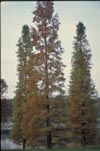Home >
Taxodium ascendens, Pondcypress
Pondcypress is found in stagnant pools of water whereas Baldcypress tends to be more common along stream banks. Both grow in water or on more well-drained soils. They tolerate drought better than could be expected for a tree so common to wet soils. In fact, trees grow faster in a well-drained, moist soil than they do in a wet site. It appears as though in nature they simply out-compete other trees in wet soil rather than prefer wet soil.
Although
tolerant of drought, some trees in the woods died in the southeastern
US as a result of the 1998-2000 LaNina weather event that caused severe
drought. This was an exceptional weather event.
The large buttress trunk is thought to develop in response to the instability of the root system inherent to trees growing in soft submerged soil. Trees tend to have a low failure rate meaning that branches break from these trees less often than from some other trees.
They
are well adapted to planting in downtown areas where there is little exposed
soil. Their narrow canopy makes them well suited for planting near buildings,
although some trees develop a wider canopy. Roots are able to grow beneath
sidewalks and pavement with little trouble. Trees planted in wet sites
develop root `knees', correctly called pneumatophores, (but perhaps less
so and are less pointed than on T. distichum) that can make mowing
operations difficult near the tree. These `knees' usually do not form
in well-drained soils. Trunks are buttressed less so than Baldcypress.
The soil pH preferred is less than 7.5, although trees can tolerate a
slightly high pH. Despite their tolerance to flooded soil trees establish
very slowly when planted in water.






